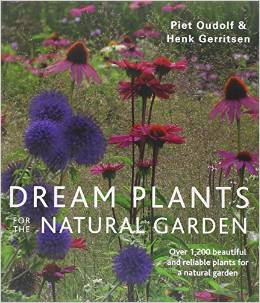 The allure of small, low maintenance gardens combined with water shortages and a desire for sustainability has led to a growing interest in “natural gardens”. Author’s Piet Oudolf and Henk Gerritsen present their choices for creating such a garden in their book, Dream Plans for the Natural Garden. The focus is on reliable perennials, bulbs, grasses, ferns, and small shrubs that look natural and can be maintained in an average garden without chemical fertilizers and pesticides or hours of work caring for the plant. Striking flowers are no longer the criterion for selection; habit, leaf shape, seed case, year round appearance, and attractiveness to wild life are all important.
The allure of small, low maintenance gardens combined with water shortages and a desire for sustainability has led to a growing interest in “natural gardens”. Author’s Piet Oudolf and Henk Gerritsen present their choices for creating such a garden in their book, Dream Plans for the Natural Garden. The focus is on reliable perennials, bulbs, grasses, ferns, and small shrubs that look natural and can be maintained in an average garden without chemical fertilizers and pesticides or hours of work caring for the plant. Striking flowers are no longer the criterion for selection; habit, leaf shape, seed case, year round appearance, and attractiveness to wild life are all important.
The book is divided up into three main sections. The first, and longest, describes reliable plants that are “tough”. That is they will grow and flower in all decent garden soils, are not invasive, will not seed themselves to any extent, and are low maintenance. This chapter is subdivided into sections on perennials, bulbs, ferns, and small shrubs. A brief description introduces the genus and further descriptions of one or more species provide details including information on sun and water requirements, hardiness zones, height, bloom time. Here we find only one yarrow included (A. filipendulina ‘Parker’s Variety’) but eight cultivars of hybrid monkshood (Aconitum). We read that the species of purple loosestrife (Lythrum salicaria) is too invasive for inclusion in the chapter but that the cultivars ‘Blush’, ‘Morden Pink, and ‘Zigeunerblut’ are less threatening.
A second section is devoted to “Playful” plants. Theses plants are just as reliable as those in the first section and include perennials, annuals, and biennials that self seed so reappear year after year if they like their site. They require a bit more time on the part of gardeners who must decide which seedlings to pull and which seedling to allow to roam and produce a more natural look over time. Included in this section are such plants as lady’s mantel (Alchemilla), mullein (Verbascum), and flowering tobacco (Nicotiana).
The third section deals with “Troublesome” plants. According to the authors these may be invasive, capricious, or demanding, The authors point out that invasive plants give a “wild” appearance to the garden in the shortest possible time but time must usually be spend controlling them. If you are up for the challenge you might consider such plants as bedstraw (Asperula), horsetail (Equisetum hyemale), or one of several loosestrifes (Lysimachia spp.). “Capricious” plants those that are sometimes unreliable for no clear reason and include Aster x frikartii, purple coneflower (Echinacea purpurea), and speedwell (Veronica spicata). The “Troublesome” plants are the ones that are demanding but are too well-loved to be omitted and add a lot to the natural garden if the gardener is willing to put in the time to care for them. This is a short section and includes only monkshood (Aconitum lycotonum), Boltonia asteroids, Delphinium elatum, and Galega officinalis.
This book is a pleasure to read. It presents the plants in a new context with insight and guidance to help readers develop their own aesthetic within the constraints of their values and available time. The numerous well done illustrations add enormously to the text and overall theme of the book. My one caveat is that since the authors are writing about conditions in Northern Europe their recommendations may not be appropriate for your garden. Different soil and climate conditions can significantly influence the reliability of the recommended plants and may be especially important when considering the use of self-seeding or invasive plants. Check with your local agricultural extension office before incorporating a particular plant into your garden plan.
To buy Dream Plants for the Natural Garden from Amazon.com click here.